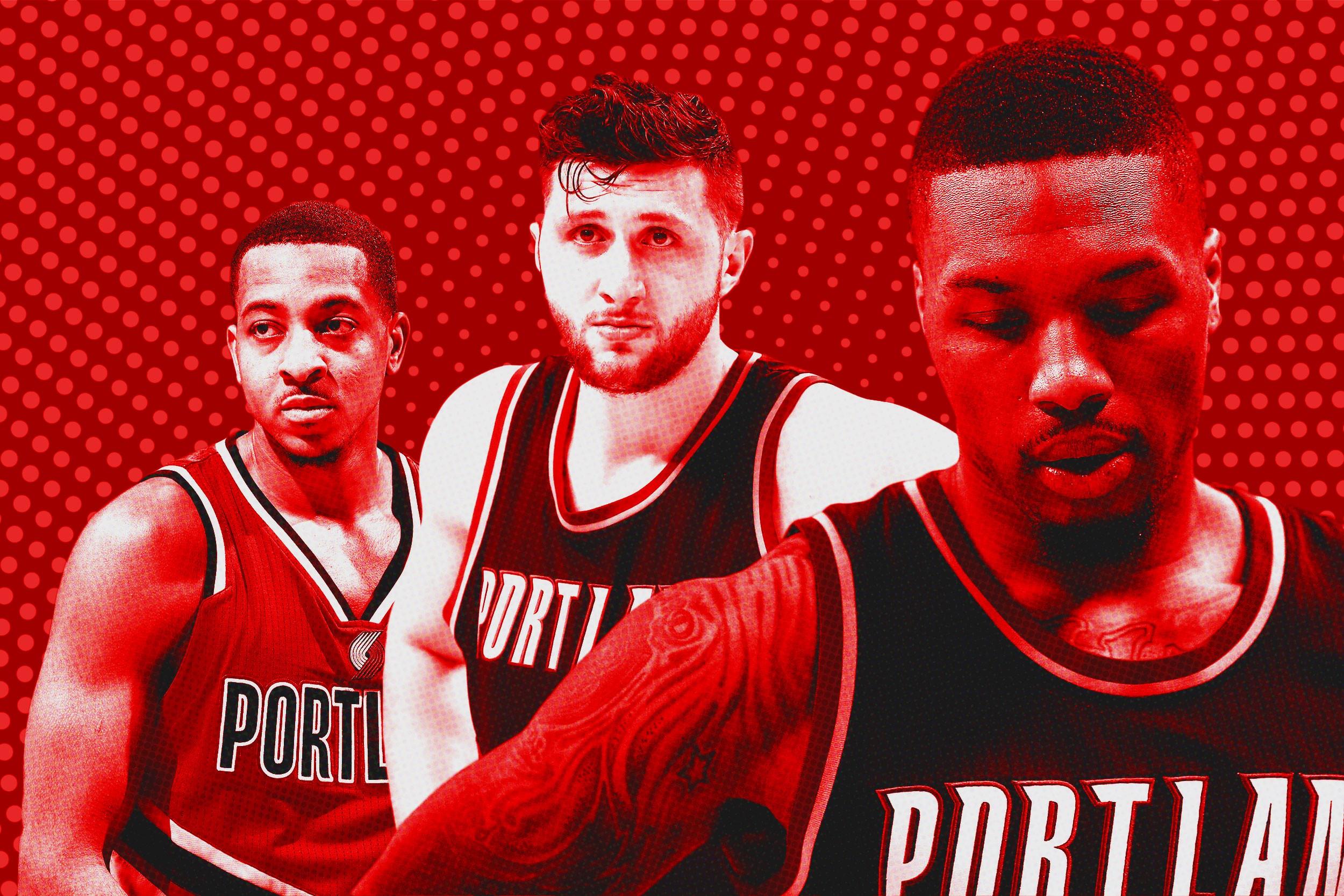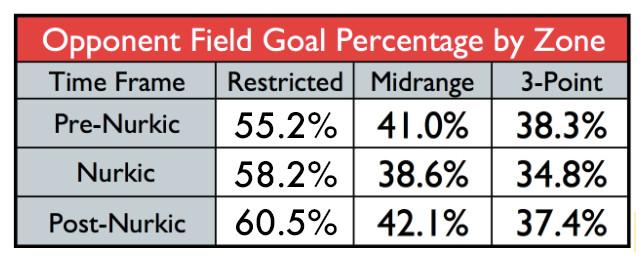
It feels strange to say coming off the back of a four-game sweep, one that ended with a Game 4 butt-whipping at the hands of the Warriors, but Portland has plenty to feel good about. The team was stellar in the second half of the regular season, with Jusuf Nurkic injecting hope directly into the veins of Blazers fans. After the Nurkic trade in early February, they went 18–9, for the fourth-best record in the NBA, with a 4.3 net rating, good for fifth best.
The team will hope the momentum from the second half of this season carries over to the next, but big questions remain that management must begin finding answers to.
1. Can the Blazers Maximize Their Draft Capital?
Portland acquired the 20th pick in this year’s draft in the Nurkic deal (the pick comes via Memphis). The pick could end up being even more important than Nurkic, because as great as the Bosnian Beast was, he still isn’t the final piece that puts them over the top. They need to find that third superstar to complement their existing bright lights, Damian Lillard and C.J. McCollum. They won’t be able to do that through free agency because they lack financial flexibility; and they likely can’t do it through trade because they don’t have the assets to acquire a Paul George or a Jimmy Butler without giving up one of their own stars. Their best shot is through the draft.
Think about how the Warriors’ championship core was assembled. Their backcourt came first. Stephen Curry was drafted in 2009 and Klay Thompson was drafted in 2011. The Blazers already have their backcourt, with Lillard drafted in 2012, and McCollum in 2013. The Warriors needed help, just like the Blazers do. Portland general manager Neil Olshey will have three swings this year (with the 15th, 20th, and 26th selections), much like the Warriors did in 2012 — the year they drafted Harrison Barnes (seventh), Festus Ezeli (30th), and Draymond Green (35th).
Olshey has an excellent draft history. As Clippers GM, he traded for the draft rights to Eric Bledsoe, who was picked 18th by the Thunder in 2010. Lillard (sixth) and McCollum (10th) were not exactly no-brainer selections in Portland. He found role players like Meyers Leonard (11th), Allen Crabbe (31st), and Will Barton (40th) through the draft as well. If I were Olshey, I would look to trade up into the lottery to draft a player with a higher ceiling — whoever that may be — but if that opportunity’s not there, and there’s a damn good chance it won’t be, I’d make an effort to retain all three picks.
Olshey should swing for fences with at least two of the selections: Indiana forward OG Anunoby, French center Jonathan Jeanne, and Purdue power forward Caleb Swanigan come to mind. For safer players, North Carolina wing Justin Jackson, Gonzaga center Zach Collins, and Kentucky center Bam Adebayo seem like fits. It’s not ideal to go into the season with three rookies, especially when you’re trying to make the playoffs, but with Lillard and McCollum locked up through 2021, Portland can afford the player-development time.
The problem with using all three picks is practical. The Blazers already have 15 players under contract for next season. They can solve that issue by waiving all three of their players with nonguaranteed deals: injured center Festus Ezeli, Orioles pitching prospect Pat Connaughton, and undrafted wing Tim Quarterman. There’s also some logic to packaging one of the picks with Meyers Leonard to dump his salary, but that wouldn’t even get them under the cap. They need one of their picks to be a home run, so they should try to maximize their swings at the plate. If one of those picks ends up being a future Jae Crowder or DeMarre Carroll, they would be ecstatic. If one of them turns into a Jimmy Butler or Draymond Green, Portland will be thinking Finals.
2. Did Jusuf Nurkic Really Fix Portland’s Poor Defense?
Portland’s improved defense fueled its resurgence. Prior to Nurkic’s debut, the Blazers’ defensive rating was 108.9–26th in the NBA. After his arrival, and until his injury on March 30, it dropped to 105.4. Nurkic was a big-body presence in the paint, a deterrent, and a rebounding machine who terrorized pip-squeak stretch 4s and undersized 5s. But their improved defensive numbers had as much to do with what happened on the perimeter as they did with what happened on the interior.

Teams shot worse from 3 against Portland after Nurkic was acquired. That’s great! But there isn’t quite a cause and effect. There have been countless studies that contend that opponent 3-point percentage is mostly pure luck. For example, teams shot 42.9 percent on wide-open 3s against the Blazers before the Nurkic trade, per SportVU, but when Nurkic was a healthy Blazer, they hit only 36.4 percent. You could conclude that Nurkic being on the floor made the Blazers better, but it’s more likely opponents simply shot worse over the small sample of attempts. “With so much randomness in just the open shots, it’s plain to see the difficulty in measuring the effect of defense,” wrote Seth Partnow, who is now the Bucks’ director of basketball research. A defense can do little to control opponent shooting success rate. It’s random.
Nurkic’s influence on shot distribution was minimal. Teams attempted as many shots in the restricted area as they did before Nurkic’s acquisition. There was a slight dip in the share of opponent 3-point attempts, but that continued to fall even after Nurkic was injured. It’s hard to find causation over such a small sample. There’s no denying that Nurkic’s rebounding and inside presence helps, but it might not be enough over the course of a full season.
3. Is Lillard-McCollum the Backcourt of the Future?
About that perimeter defense: Lillard and McCollum are leaky valves on that side of the floor. They make up one of the league’s most lethal scoring duos, but the impact of their offense is dulled by the porousness of their defense. It’s understandable if they have defensive effort issues during the regular season, considering their immense offensive workload. But the playoffs are another thing. Even when these two undersized guards work hard, they can’t get stops.
McCollum, at 6-foot-4, doesn’t have the strength or lateral quickness to contain penetration:
Lillard, who’s 6-foot-3, has an even leaner frame, plays flat-footed perimeter defense, and struggles to fight through screens:
Even if Portland has some draft luck and lands a stud, and even if Nurkic sustains his success from this season, this backcourt still might be too flawed on defense to go on deep playoff runs. It’s hard enough to hide one player on defense, never mind two — especially when those players need to defend the most explosive scoring positions in the NBA.
If the Blazers want to be a feel-good team that jogs in place, the status quo is fine. But if the goal is to bring a title back to Portland for the first time since 1977, then Olshey needs to check the history books.
Only one of the past 20 champions finished with a defensive rating outside the top 10. Over the past 36 years, only one team had a relative defensive rating worse than the league average, according to numberFire. That team was the 2000–01 Lakers, which featured Kobe Bryant and Shaquille O’Neal. This season’s Cavaliers could become the second team. They have LeBron James. C.J. and Dame are good, but they aren’t on the Kobe-Shaq-LeBron level.
Let’s go back to the Warriors for a minute. They not only drafted well, but they made forward-thinking trades. In 2013, they cleared cap space and dealt two first-round picks in a sign-and-trade for Andre Iguodala. Maybe someday Evan Turner can be Portland’s Iguodala. In 2012, Golden State dealt Monta Ellis, at the time its second-best player, for Andrew Bogut. McCollum and Lillard are both far better than Ellis was, but breaking up the tiny backcourt of Ellis and Stephen Curry ended up being the key to Golden State’s future title runs. Klay Thompson is one of the NBA’s best perimeter defenders, never mind a premier shooter. Neither McCollum nor Lillard has that upside.
It’s sacrilegious in Portland to suggest a McCollum or Lillard trade, especially this summer, after such a promising stretch run. But a big shake-up might be what it’ll take to get the Blazers over the hump.